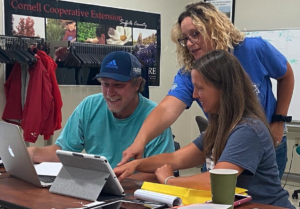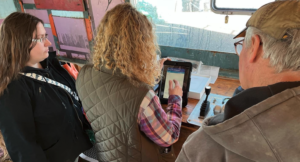Fishermen hailing from the Northeast US (states between Maine and North Carolina) have been required to submit paper Vessel Trip Reports related to their fishing efforts. Vessel Trip Reports (VTRs) are used to collect data that helps to inform fisheries management decisions- helping to keep track of what was caught, where it was caught, what gear types were used and where it was sold. Electronic vessel trip reporting has been an approved method of vessel trip report submission in the Northeast since 2011, but had been voluntary.
By early 2020, the Mid Atlantic Fisheries Management Council (MAFMC) and New England Fisheries Management Council voted to require commercial fishermen to submit their Vessel Trip Reports (VTRs) electronically as eVTRs. This decision was made to increase timeliness and availability of data submitted through VTRs; reduce the reporting burden on commercial vessel operators by eliminating the need for paper-based reporting; and increase the accuracy and quality of data by reducing errors from trying to recall catch and effort associated with delayed completion of paper forms (MAFMC, 2020). The mandated transition to electronic reporting came into effect on November 10th, 2021, requiring New York’s 279 federally permitted commercial fishermen to electronically submit their VTRs. However, Northeast fishermen and their fish dealers at the dock have been accustomed to submitting paper reports for their entire careers. There was a clear disconnect in technological understanding between the fleet and management. Fishermen needed to be properly introduced, trained, and equipped with the new technology to remain in compliance when submitting reports.

Cornell Cooperative Extension of Suffolk County (CCE) has been working with the marine industries of New York for over 30 years. CCE is one of the only groups on Long Island that works directly with local commercial fisherman. We help to ensure this unique and historical way of life is preserved. We work with local, state and federal managers to ensure local fishing is sustainable. To help facilitate this transition, CCE has been conducting an outreach and training initiative targeted at New York fishermen. The project was developed in collaboration with New York State Department of Environmental Conservation (NYSDEC), Greater Atlantic Regional Fisheries Office (GARFO), Mid-Atlantic Fishery Management Council (MAFMC), Atlantic Coast Cooperative Statistics Program (ACCSP) and Electronic Technology (ET) specialists and was funded by National Fish and Wildlife Foundation (NFWF) Electronic Monitoring and Reporting Grant Program in the 2020 funding cycle.
The Project
CCE’s “New York Fleet Wide Electronic Vessel Trip Reporting and Education Initiative” is focused on helping New York commercial fishermen become proficient with the eVTR reporting process. While electronic submission has become mandated for federal permit holders, New York State permit holders (of which there are 1,622) are also able to and encouraged to submit VTRs electronically. Throughout the project, CCE has provided qualifying fishermen with tablets and hands-on training in two accepted eVTR methods, using either the Fish Online program developed by NOAA Fisheries, or ACCSP’s Standard Atlantic Fisheries Information System (SAFIS) eTRIPS/mobile app for commercial fishermen. These apps were created with the fishermen in mind. They are as user-friendly as they can be, mimicking the organization of the old paper VTRs. Without the need for an internet connection until the fishermen is ready to submit, these apps serve as the VTR while fishermen are out at sea as well and can be shown to coast guard officers upon random inspection. However, for older generations of fishermen, and those unfamiliar with such technology, the need for training remains.
Throughout the course of the project, CCE has hosted 8 workshops at various locations near the most populous commercial fishing ports on Long Island. In these trainings, CCE staff would help fishermen set up their Fish Online Accounts, sign into and register for the app, and take them step by step through the submission process. While the training itself can often be completed in 45 minutes to an hour, CCE staff typically stay on site for the day to accommodate varied schedules. Workshops and one-on-one training began in the spring of 2021, allowing several months for fishermen to become familiar with the eVTR submission process prior to the November 10th deadline. To help reach fishermen who were unable to attend in-person workshops or trainings, online training sessions were also made available. To date 51 tablets have been provided to fishermen, and technical support has been offered on an as-needed basis through the life of the project. Though some fishermen have required multiple trainings, overall, there has been overwhelming success.
The Industry
New York is home to 279 federally licensed commercial fishermen, and 1,622 state license holders, many of whom reside on Long Island and hail from ports in Hampton Bays and Montauk. These fishermen target a variety of species, including squid, whiting, scup, butterfish, fluke, striped bass, and monkfish.

CCE first focused their efforts on 40 highly active commercial fishermen. Highly active vessels are defined as those who fish at least 150 days out of the year, and therefore contribute a significant proportion of NY’s annual landings. By identifying and targeting these high liners, the project could improve the adoption of electronic reporting for some of the region’s highest-yield fishermen. Following the training of these 40 fishermen, CCE has continued to expand their efforts to include additional training sessions and workshops for more fishermen, to reach over 200 fishermen. This would represent the majority of the federally permitted fishing industry of New York and begin to reach New York state (NYS) permitted commercial fishermen as well. So far, CCE has held 35 in-person training sessions, and have provided 189 NYS permitted fishermen with training materials and instructions. As of 11/15/21, 62% of NY fishermen with federal permits had reported electronically. There has been a 20% increase so far compared to 2020 when only 42% of fishermen with federal permits were reporting electronically. This number is expected to rise through the next reporting period as system kinks are ironed out and the mandate to report electronically becomes stricter.
Benefits of Modernization
The main benefit of moving toward an electronic reporting system is a significant improvement in accuracy and timeliness of fishing data. Moving away from paper reporting has been shown to reduce data entry and transcription errors frequently cited by resource managers as recurring issues. The current electronic system is designed to restrict the entry of erroneous or incomplete data. For example, if a fisherman were to accidentally omit the sales data for one of the caught species listed, the application would provide a warning to the fishermen prior to submission of the VTR to correct the error. As fishermen use the apps, their personal account will become tailored to their fishing practices. Information that is frequently entered the same over multiple trips, such as species caught, fish dealer, chart area, and gear type – will appear automatically, reducing the time needed to search for those items on provided lists. This is not to say the apps are inflexible; switching between options is a quick and easy process. These features will lead to improved data quality over time.
However, as with all technology, the apps can, in some cases, take a few attempts to gain familiarity with the system, thus the initiative funding training and workshops. CCE and GARFO have also developed step-by-step instructions for those who struggle with the process following their in-person training. Issues with the apps themselves have not been unheard of, though. Glitches and human error have occurred, requiring fishermen to resubmit previous reports. Human error, though, continues to be the leading driver slowing down the transition. One of the more recent issues has been where fish dealers may be neglecting to copy down the entire fourteen-digit

eVTR number from the fisherman’s report. This leads to issues at NOAA, where the eVTR must be re-entered, often by the fisherman who landed the fish.
Outcomes and Lessons Learned
Thus far, the project has been met with great success. CCE has distributed and trained their target 40 high-liner fishermen and have offered support and training to additional fishermen. More and more fishermen are submitting eVTRs, and technical support is needed less frequently. It is our goal that by the end of the project period at the end of April 2022, all our target audience will be familiar with the electronic submission process and will only need occasional assistance.

While there have been some challenges, these are to be expected following the implementation of new technology. Technical issues with the application, fishermen’s unfamiliarity with the submission process, and their reluctance to submit electronically are all expected to diminish over time.
I want to thank CCE Fisheries Specialists Amanda Dauman and Alex Mercado for their help in preparing this article.
Scott Curatalo-Wagemann is an Extension Resource Educator at Cornell Cooperative Extension (CCE), in Riverhead, New York. He welcomes your questions or comments. Find more about CCE in our Community directory. Projects in the Field is a series of independently produced articles profiling work supported by NFWF’s Electronic Monitoring & Reporting Grant Program, and is meant to raise awareness and support for these important initiatives.


